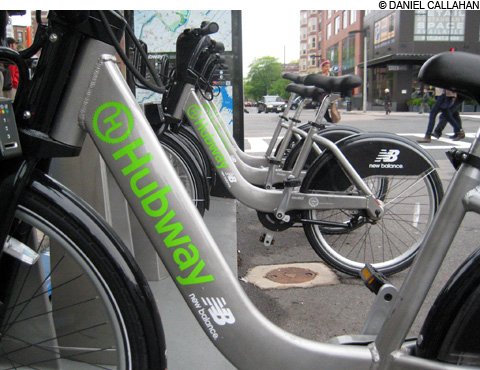
FRUITS OF HER LABORS Nicole Freedman oversaw the implementation of the Hubway bike-share program. |
After a five-year reign as Boston's first unofficial "Bike Czar," Boston Bikes director Nicole Freedman will be abdicating her throne to direct Maine's Huts and Trails program. She leaves behind some impressive accomplishments: Boston now boasts 50 miles of bike lanes (up from less than one in 2007), not to mention the Hubway bike-share program, and a bike training initiative that's introduced more than 8000 Boston public-school students to the joys of cycling. City Hall has yet to find a permanent replacement for Freedman, but whoever it is, they'll have some big shoes to fill.
WHEN YOU STARTED WITH BOSTON BIKES IN 2007, THE CITY HAD MAYBE A MILE OF BIKE LANE. LOOKING BACK, WHAT DID YOU THINK YOUR BIGGEST OBSTACLE WAS GOING TO BE? I think the mayor was very clear when he launched the [Boston Bikes] program — he wanted to make Boston into a world-class biking city. He recognized the fact that we were the worst cycling city in the country and acknowledged that we could turn this around. We needed to hit the ground running and get bike lanes on the ground to prove to the public that we could make it happen.
AT THE FOURTH ANNUAL BOSTON BIKES UPDATE THIS FEBRUARY, IT SEEMED LIKE YOU GUYS WERE DEBUTING THE NEXT IPHONE OR SOMETHING — THE BOSTON PUBLIC LIBRARY AUDITORIUM WAS PACKED, EVERYONE WAS REALLY EXCITED AND ENGAGED. I THINK IT WAS THE FIRST TIME THAT I SAW SUCH A POSITIVE AND ENTHUSIASTIC CROWD AT A PUBLIC MEETING FOR THE CITY. That meeting was really special. It was a celebration of what the whole community had done together. We've become one of the best biking cities in the country, and every person in that room contributed to everything that's taken place.
DO YOU THINK THAT WHAT BOSTON BIKES DID COULD BE A BLUEPRINT FOR GETTING PEOPLE MORE INVOLVED AND ENGAGED IN CITY GOVERNMENT? It was a very successful model with the community working with the city. We were all aligned. The mayor, the city officials, the public were all working together to fulfill a common vision.
BOSTON BIKES IS ABOUT TO UNVEIL THE BICYCLE NETWORK PLAN, WHICH WILL OUTLINE A CITY-WIDE AGENDA FOR NEW BIKE LANES AND TRAILS. ONE OF THE PLAN COMPONENTS YOU'VE DISCUSSED IS SOMETHING CALLED "NEIGHBORWAYS." WOULD YOU EXPLAIN WHAT THOSE ARE? The goal is to create a network that's welcoming to all levels of cyclists. That would include people who haven't biked in 30 years, families, kids, and senior citizens. The concept for "neighborways," which are also called "bike boulevards," takes a street that tends to be low-volume in terms of car traffic, and makes it function as a very safe street for cyclists. It'd be a road anybody would feel comfortable biking on.
WHICH STREETS COULD BECOME NEIGHBORWAYS? There are a lot. One of the difficult things is that we're not planned on a grid system like other cities, so it's more complex. Shawmut Avenue in the South End would be a good candidate.